How to make a warm floor on a balcony and loggia: choosing a heating system + installation instructions
Various heating systems, installed mainly in the floor, are used as a source of thermal energy for the loggia. They allow you to maintain optimal temperature conditions and create the most favorable conditions.
There are several options for arranging underfloor heating. To make the right choice, you need to compare the pros and cons of each decision.
We will tell you which heated floor on the balcony is preferable in a given situation, and also provide step-by-step instructions for installing the heating system.
The content of the article:
Heating systems for loggias
There are several types of heating systems installed in the floor and used to insulate balconies and loggias.
All devices belong to electric heated floors::
- heating mats;
- two-core heating cables;
- infrared screened film.
Let's look at the systems in more detail.
Heating mats and their types
One of the most popular and budget systems are heating mats. They represent a single heating cable, attached in a wave-like manner to a special mesh made of durable fiberglass. The devices belong to the class of systems with cable heating; they are installed exclusively on the floor.

A single- or double-core cable acts as a heat source.Its diameter varies in the range of 2.5-4.5 mm. To operate the mats, a power source of 220-230 W is required.
The cable is protected by a special plastic shield. The length of the cold wire usually exceeds 2 m.
Industrially produced heating mats are divided into two groups.
They are divided by cable type into:
- single-core;
- two-core;
Single-core systems. Their peculiarity is that they must be laid so that the two ends are connected to the thermostat. This significantly complicates installation, since cutting of mats is required.
Also, a mat with a single-core cable emits an electromagnetic field, so it is not installed in rooms where people are constantly present.
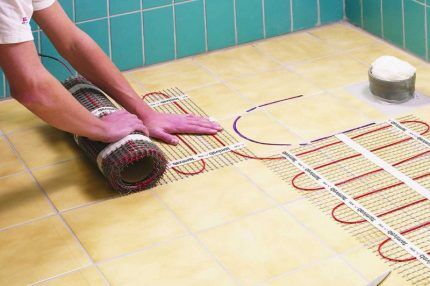
Double wire mat – an improved modification of single-core. Here, in addition to the heating core, there is an electrical cable. Its implementation in the design allows one end to be connected to the thermostat, and the other to be hidden in the coupling, which makes it possible to complete installation anywhere.
The two-wire type mat practically does not emit an electromagnetic field, therefore it is completely safe for humans. It can be installed not only in the balcony floor, but also in any other room as a source of additional heat.
Heating mats also differ in power and can generate from 60 to 2300 W of energy. You can read below about how to calculate the required power of the mat.
Both single-core and double-core mats are reliable and can serve flawlessly for many years.Typically, single-core modifications are thinner than double-core ones, have more power, and therefore are able to warm up the floor surface faster.
Pros and cons of heating mats
Let's consider the features, advantages and disadvantages of heating mats.
- When using mats, the height of the room is reduced by only a couple of centimeters, taking into account the height of the tiles and the adhesive layer.
- The system is economical and uses electricity efficiently. If there is furniture on the balcony, then mats cannot be placed under it.
- Heating mats are easy to install. The only point that may cause difficulty is connecting the system to the thermostat.
- Heating mats are used for short periods of time. They are not designed for constant 24/7 operation.
You can apply tile adhesive on top of the mats and lay the tiles themselves. The choice of device takes into account the area of the heating surface and the heat loss of the loggia. For installation on a balcony, it is not advisable to take a long mat, since the device cannot be shortened.
You can only reduce the cold ends, so for the balcony you need to select a device that best matches the floor area.
Installation of heating mats
Installation of heating mats must be carried out with care. It is important to protect the cable from mechanical damage. It is unacceptable to use cutting or sharp objects during installation or leave them unattended.
It is also important to try not to step on the cable. To eliminate the possibility of this incident, it is advisable to carry out installation in shoes with soft soles or without shoes, and before installation, the floor surface is completely cleaned of dirt.
Care should be taken when fixing the tiles, applying adhesive and cleaning the seams. While performing this work, you may accidentally damage the cable.
The installation of an underfloor heating system using heating mats includes a number of traditional stages:
Let's consider options for laying mats on different types of surfaces.
First, heat-insulating material is installed on the concrete floor of the loggia, then the floor is leveled, and a shock absorber is installed that will prevent deformation when heated. Then a mat is placed on the shock absorber, after which it is covered with tile adhesive, on which the tiles are laid.
At the last stage, the protective tube for the temperature sensor, thermostat is installed, and the cold wires are connected.

If the floor on the balcony is made of wood, then the surface is first leveled with a concrete layer of 7-9 mm, then heating mats are laid, hard foam is laid, and then the floor is covered with wood.
If the installation is carried out on an old tile covering, then make a concrete screed, install a heating element, cover it with tile adhesive, and then create a new tile covering. If the floor tiles were in good condition, then leveling screed may not be necessary.
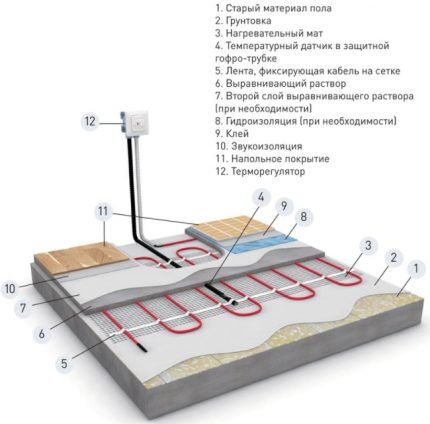
Let's take a closer look at the installation features.
Before introducing mats into the floor surface, it is necessary to draw up a schematic installation plan.
The project should display:
- heated surface contour;
- laying diagram;
- location of the temperature sensor, thermostat, taking into account the location of the power supply wiring.
Before starting work, it is important to prepare the surface for laying mats. To do this, eliminate cracks on the floor with putty. After it dries, the floor is cleaned of dust and dirt.If the surface is wooden, you need to make sure that it is securely fixed.
Before installation, you need to install a groove for the tube that comes with the temperature sensor. It is important that it is located at the level of the top edge of the product at the same distance from the heating cables.
During work, you need to seal the tube on one side with electrical tape so that tile adhesive does not get into it. The second end is connected to the thermostat itself, which is located in the junction box.
Installation can be done in two ways - cable up or cable down. The first method is the simplest and is used most often in practice.
The method in which laying is done with the cable up is that the mats are laid with the mesh down. Next, using glue, the device is point-fixed to the floor surface.
Afterwards, tile adhesive of the required thickness (usually 3-5 mm) is applied to the surface of the mat, after which they begin laying the tiles.
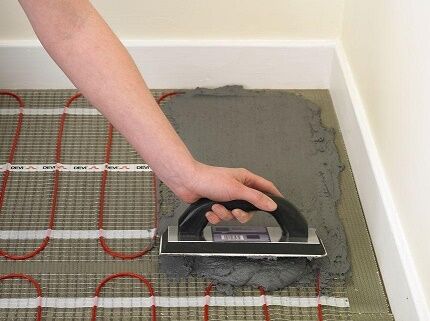
The cable must be completely immersed in a heat-conducting medium (tile adhesive, etc.).
The method in which the cable is laid with the cable down (i.e., with the mesh up), is more difficult to implement. Before laying the tiles, a mat pattern is made. To do this, it is spread out so that it completely covers the heated surface.
Next, the mat mesh is cut and then rolled up. A 2-3 mm layer of glue is applied to the floor, after which the mat is unrolled with the cable facing down and pressed lightly.
During installation, it is important to ensure that the distance between the cables is not less than 5 cm.A second layer of 5-6 mm adhesive is applied with a notched spatula directly onto the heating mat, after which the tiles are laid.
Heating electric cable
The basis of any underfloor heating system is an electric heating cable. It acts as the main heating element. Control occurs using electronic thermostats of various modifications.
For the device to function, a voltage of 220 V is required.
The cable system includes a cable heating section, its main element is a two-core shielded cable, which is connected on one side by a supply conductor protected by a coupling, and on the other by a heating core.
The specific heat dissipation of the cable is approximately 18 W/m.
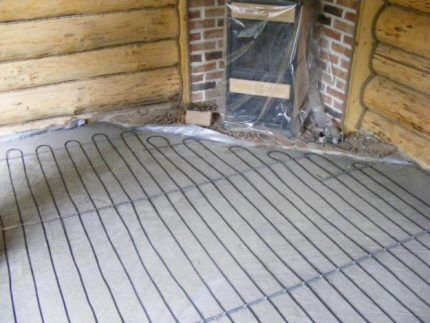
The advantages of the cable are as follows:
- the electromagnetic field created by the device is completely safe for humans;
- Thanks to the use of a low-power heating core in the design, the wear resistance of the cable and its service life increase;
- ease of installation;
- The shielding film ensures electrical and fire safety of the product and protects it from mechanical damage.
Installation on a concrete floor has a number of features. It is advisable to insulate extruded polystyrene foam 20-30 mm thick or any other heat-insulating material.
Next, you need to cover the thermal insulation with a 10-15 mm concrete screed. This will prevent contact of the insulation with the floor heating element, otherwise the device may overheat.
After the procedure, a mounting tape is placed on the floor and fixed. The cable is laid evenly in waves over the entire area. It is important that its nodes do not intersect. The bending radius must be equal to or more than 10 times the cable diameter. Fix the device using mounting tape, securing the protruding parts with it.
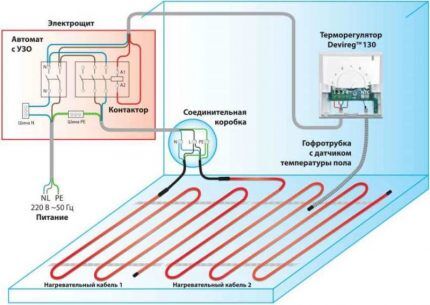
After installation, check whether the actual resistance of the heating core matches the information in the passport. You can connect the cable before installation to check its functionality, after which you can lay it and tie it.
The couplings must be located in the concrete screed.Before the cable ties device, a cable laying diagram is drawn up, where the locations for the location of the couplings are determined.
It is important to remember that the cement screed completely hardens after 28-30 days. Until this time, the system cannot be turned on. It is also prohibited to run sections of the heating cable that are in a folded position. The laying step must be calculated according to the passport.
A brief photo instruction will introduce you in detail to the stages of laying the heating cable on the floor of the loggia:
Infrared heating film
The operating principle of IR film is based on the generation of long-wave IR rays. The device itself has the appearance of a canvas covered on both sides with a polyester film. It is flexible, making it easy to install on any part of the floor.
Installation does not require pouring a cement screed or installing an adhesive base; the film can be easily installed and dismantled.
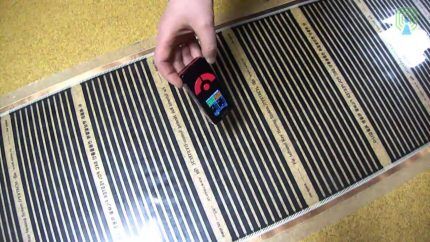
The film is a kind of emitter of infrared rays, which a person interprets as heat. Its maximum heating temperature is 50°C.
Any IR film consists of:
- carbon heating element, which is a converter of electricity into heat;
- bimetallic tires, with the help of which energy is supplied to the heating elements;
- two-layer polymer film, performing the functions of protection against mechanical damage.
The device operates from an electrical network of 220-230 V.
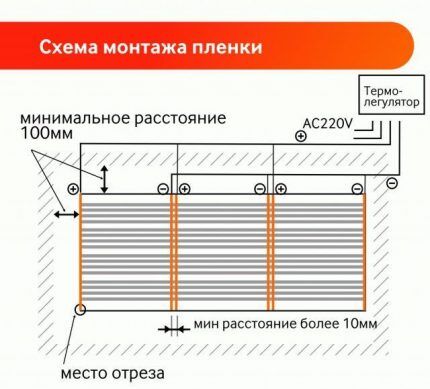
The current passing through the components of the system is converted into thermal energy, which is transferred to the surrounding environment, which then heats the air mass around it.
Types of infrared films
There is a wide variety of IR films, differing in specific technical parameters and appearance. There are two main types – low- and high-temperature models. Films also differ in power, maximum heating temperature, thickness, width, and areas of application.
Installation of a continuous carbon film, used as the main heating system of an equipped loggia, is quite simple:
When choosing a film, the key parameter is its heating temperature. So, if it exceeds +27°C, then the laminated coating should be discarded, since it is irreversibly deformed when exposed to high temperatures.
Therefore, high temperature modifications should be lay under ceramic tiles.
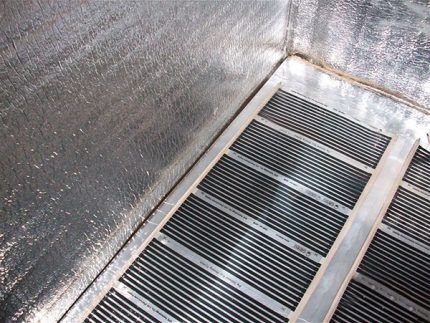
In the loggia, you can install warm IR film both on the floor and on the walls and ceiling. Additionally, the panels are mounted on both walls under the windows, opposite the windows. This heating method is called - heating system PLEN.
At choosing IR film It is important to focus on the area of its application.
The compelling benefits of IR film
Experts highlight a number of advantages of IR film.
The main advantages include:
- environmental Safety - radiation is considered beneficial to health;
- maintaining quality air composition — when the device operates, it is not the air that is heated, but the interior items, so oxygen does not evaporate and the composition of the air does not change;
- no radiation electromagnetic type;
- ease of installation, wide possibilities for customization.
IR film is durable, practically does not fail and does not require repair.
Infrared film systems work well in open areas. They are actively used in the arrangement of balconies and loggias. A significant advantage of IR floors is that this is the only option that allows you to effectively heat rooms without glazing.
The process of installing an IR system on the balcony floor is presented in the following gallery:
If you are planning to choose IR film for your balcony, we suggest that you familiarize yourself with the information on installing and connecting such a heated floor:
- Infrared carbon heated floor: principle of operation and installation rules
- How to make an infrared heated floor with your own hands: installation and connection of a film floor
Temperature sensor installation
To ensure the necessary microclimate in the room, thermostats equipped with a temperature sensor are used. They interact effectively with cable systems and IR film.
The functions of the thermostat include maintaining the set temperature, adjusting it, and optimizing energy consumption. Depending on the modification, the functions of the device may vary.
The principle of connecting the thermostat is the same for any system. We will consider the features of installing a temperature sensor for heating mats.
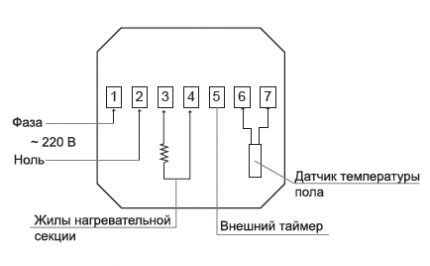
If the total power of the mats is greater, then for thermostat installation Additional equipment is required in the form of an input circuit breaker, an RCD, a power relay, a directional circuit breaker, and a special thermostat.
To install the regulator, you must perform the work in the following order:
- create a special hole in the wall for mounting the box;
- make a recess in the wall to install the power wire and create a hole for laying the connecting channel;
- perform installation and configuration according to the instructions;
- place the sensors in a corrugated plastic tube with a diameter of 16-20 mm.
The tube must be hermetically sealed at one end to protect the wires from solutions and water getting inside. From the opposite end, the tube is placed in the installed box.
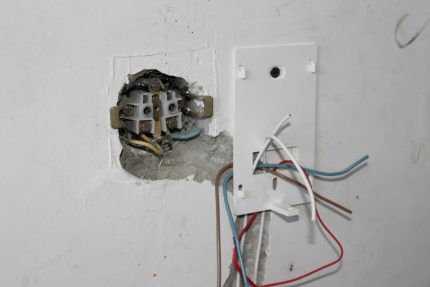
The permissible bending radius of the wiring is at least 5 cm. The tube with sensors is attached to the floor. It must fit between the loops at a distance of at least 20 cm.
It is important to remember that during installation you cannot shorten the heating cable, replace supply wires, make adjustments to the design of the thermostat, or carry out repair and installation work with the supply voltage turned on.
Principle of calculation of floor systems
Before choosing any floor system, it is important to calculate the power of the heater and determine its required length.
To do this, you need to calculate the heat loss of the loggia. A lot of thermal energy comes out through window openings, so ensuring a temperature of +20-+23°C is quite problematic, especially in the winter season. Therefore, it is recommended to install heating equipment in heating mode.
You can calculate the heat loss of a balcony using an online calculator.
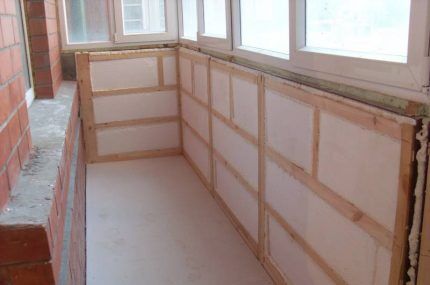
The recommended temperature of heating mats, cable or IR film is +26°C. This mode is suitable for heat-insulating parquet floors. If tile, marble or other heat-conducting coating is used as a coating, then the recommended cable temperature is +28-+31°C.
Usually for loggias you need 160-180 W per m2 for heating and 200-220 W per m2 for heating mode. Taking these recommendations into account, you can calculate the required cable length, laying pitch, and system power.
For example, a loggia has an area of 2 m2. The flooring is tiles, no screed is planned. Let's take the heating mode, which requires 200 W per m2. Next, we determine the heating area.
It is calculated using the formula:
Sgr=Sgenerally-Setc, Where
- Setc - the area occupied by cabinets and other furniture;
- Sgenerally - total area of the room.
Let's say the area occupied by furniture is 0.5 m2. Then Sgr=2-0.5=1.5. The heating mode is selected for the loggia, so the required cable power is 200 W per m2.
Then the recommended system power is 1.5 * 200 = 300 W per m2.
If a screed is not planned, choose a thin cable system that can be completely embedded in a layer of tile adhesive.
You can select a system with the required characteristics using tables describing the characteristics of the equipment.

Based on the table, we determine the thickness of the mat, its dimensions and length based on its area. In our example, the power of the mat is 0.25 kW, and the length is 17 m.
Next we look for the installation step. We calculate it using the formula:
h=(Sgr*100)/Lcab, Where
- h — laying step;
- Lcab — cable length in meters.
We substitute the values into the formula and get: h=1.5*100\17=8.8 cm.
When laying mats or cables, remember that the distance from the walls should be 10 cm.
Conclusions and useful video on the topic
The video describes the features and general principles of installation of heating mats:
From the video you can learn about the features of installing and connecting the thermostat:
You can learn about installing IR film from the video below:
Cable systems and IR film are of high quality, low cost, practicality and durability. You can install them yourself without involving specialists.
It is only important to choose the right equipment, taking into account the area of the heated surface, type of coating and other factors.
We invite everyone interested in the issue of heating a balcony and using heated floors to heat a loggia to leave comments and ask questions. The contact form is located in the lower block.




I don’t know about others, but our balcony is our favorite place to hang out; our one-year-old child especially loves to spend time there. This is probably why I had to think about insulating the floor there, since it was constantly cold in the unfurnished balcony, and the baby always plays on the floor. Having studied all the methods of insulation, we chose IR film, as it is completely safe and durable to use.
We only have floors with heating mats inside the house. There is now infrared film in the hallway and on the balcony. Initially, there was a floor with heating mats, but one day the children forgot to close the door from the street to the hallway when leaving. It’s good that the thieves didn’t break in, but the floor failed due to a sudden change in temperature, and it was freezing outside. Then my husband and I decided that it would be better to install a film heater on the balcony and in the hallway. He, as time has shown, is not too capricious.
The article is, in principle, useful, but when discussing infrared flooring... “when the device operates, it is not the air that is heated, but the interior items, so oxygen does not evaporate, the composition of the air does not change;”, this is tough... Evaporation occurs only from liquid phases; a liquid substance turns into a gaseous one. Very few people store liquid oxygen on the balcony, and the infrared floor, at the temperature of liquid oxygen, will most likely turn into a superconductor and thereby burn out the wiring or prevent the machine from turning on in the panel.
Correct me please! The composition of the air does not change with any type of heated floor; at most, the humidity can change. If we meant “oxygen combustion,” then this is also air humidity.
Hello. Thanks for the note, we'll fix it
How long can I use IR rod floors? Brief activation? Is it possible 24/7? Or are there other rules? The same with film IR floors. Condition: when installing such a floor on a balcony.
Good afternoon Please tell me, is it possible to use IR flooring under adhesive quartz vinyl (PVC wicker)?